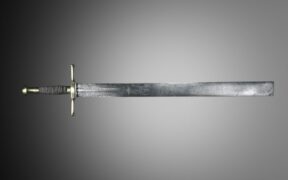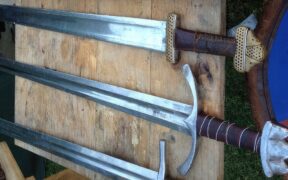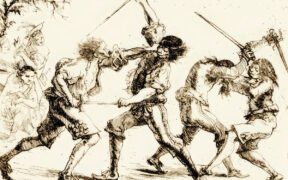Our content features commercial links to our products, committed to transparent, unbiased, and informed editorial recommendations. Learn More
The Hanger Sword That Did Much More Than Just “Hang”
NO AI USED This Article has been written and edited by our team with no help of the AI
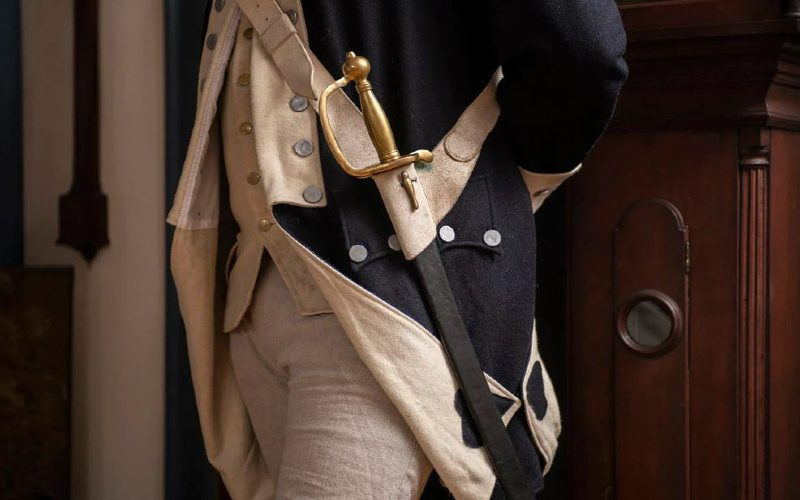
A Hanger Sword is a bladed weapon that got its name from the manner in which it was hung on the belt of the person who used it. It could be made in large quantities, is not particularly expensive to do so, and was first used as a hunting weapon before being put to use in combat.
In this article, you will find out everything you need to know about the Hanger Sword. First, we shall start off with the different types of this sword. Then we will go over its general characteristics and explain how they can be best put to use. We shall conclude the article with its history and how it compares to the cutlass, which also hung off people’s belts.
Types of Hanger Sword
The Hanger sword was a type of saber that was very short and mainly placed on the belts of its owners for convenience and ease of access, hence the name. It was a very simple sword that was practical and had many uses. Its versatility is the reason why there are many different types of it.
Cutting Hanger
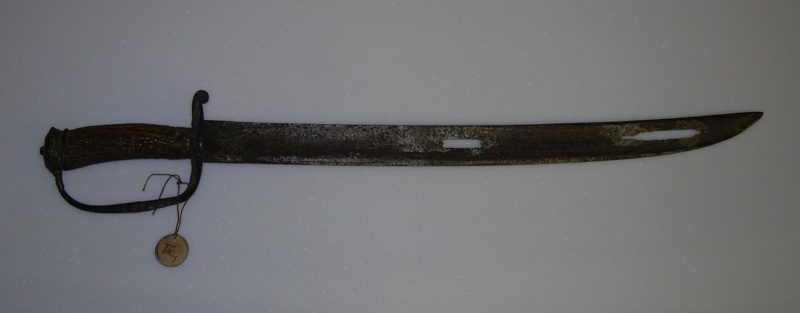
The first type of Hanger sword was the Cutting Hanger. This single-edged and slightly curved sword hung from the belts of foot soldiers as a military sidearm, mainly in 16th-century Europe.
They were easy to create and didn’t have any decorations. They were meant to be used with hacking motions and didn’t serve as a status symbol. It has a wide fuller and blade. The overall length of this type of Hanger sword is around 29 inches (75 cm).
Hunting Hanger

Originally the Hanger sword was created for hunting, not warfare. The Hunting Hanger was a short, curved, or sometimes straight sword. It also originated in 16th-century Europe and was very practical to use for hunting.
It was used by common folk and made very simple, but when it was used by the nobility, it had very decorated handles, guards, and blades. The overall length can be between 23 to 31 inches long (60 to 80 cm).
Infantry Hanger

This type of Hanger Sword was primarily used as a substitute for the bayonets used by many armies throughout the 17th and 18th centuries.
The Infantry Hanger is a crude, military variant of the short hunting sword and was also much more practical in difficult terrain than the more conventional long swords at the time. It has a length of around 31 inches (80 cm) which was shorter than any typical cavalry sword used at the time.
Naval Hanger

The Hanger sword was favored and popular among naval personnel, which led to their own variant, the Naval Hanger Sword. It is made just short enough to be perfect for close-quarter combat and therefore was not a nuisance to carry around when sailing and going between decks.
This type of Hanger sword was slightly curved so that it won’t interfere with sailors when they were running or walking around. It is also much shorter than the regular type of Hanger and is around 19 inches (50 cm) in length.
Straight Hanger

A much rarer version of the Hanger, the Straight Hanger doesn’t have a curve to it. The blade’s tip can be sharpened from both sides to make it deadlier when thrusting at enemies.
The straight Hanger was more commonly used for decorative purposes and as a status symbol for higher ranks and the nobility. The typical length for this style was around 29 inches long (75 cm).
Characteristics of the Hanger Sword
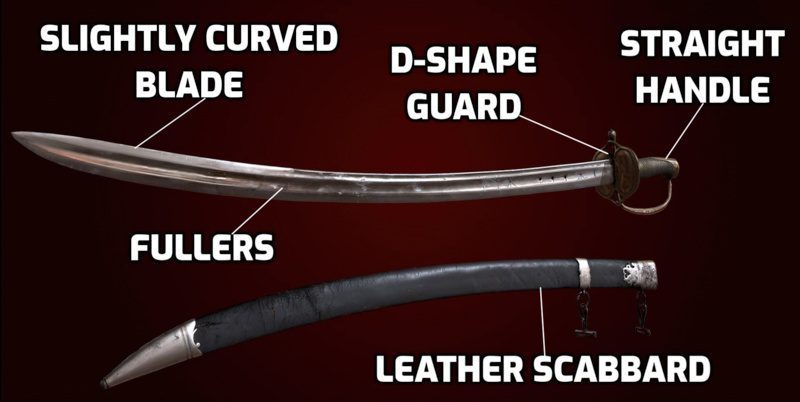
The most visual and strongest characteristics of the Hanger Sword are that it is a short sword, has a slight, delicate curve to it, and is simple in design without anything ornate attached or engraved on it. They were meant to be used for warfare and were rarely used for decoration.
Blade
The Hanger Sword has a very slight curve to the blade, which makes it much more powerful for slashing attacks. The blade is single-edged, which means that only one side of the blade is sharpened and ready for battle. On occasions where the blade is straight, it was often sharpened on either side of the tip to make it more effective for stabbing attacks.
The Hanger blade has fullers on it, which are the beveled lines in the center of the blade that lessen the overall weight of the sword. The most common length of the Hanger Sword’s blade is 21 inches long (55 cm).
Guard
The guard of the Hanger Sword is typically in the shape of the letter D. This style guard provides great protection for the user’s hands and offers a much stronger grip. Because this sword was also used as a symbol of nobility, the guard could have intricate designs, such as S-shaped quillons, which were highly decorated.
There are occasionally crucifix-style guards too. Albeit, this is the rarest type of guard for the Hanger. This is commonly found on early versions of the Hanger sword that were used for hunting.
Handle
The handle of the Hanger Sword is straight but can sometimes have a slight curve that mirrors the curve of the blade. Usually, the Hanger has a very simple handle design and material, but if it were for the nobility, it would have decorations made from ivory or steel.
The average length for the handle of the Hanger Sword is 4 inches long (10 cm) which meant that it could really only be used with one hand.
Pommel
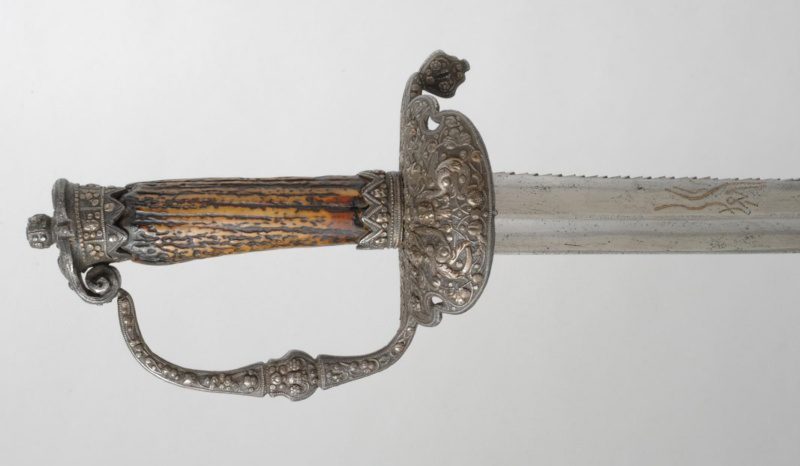
Most Hanger Swords will have a cap-type pommel, which looks like it was added to the handle. Usually, the pommel of the Hanger is very simple, but if it was used by the nobility, it could have decorated pommels like an animal-shaped one, for example.
Scabbard
While it is called the Hanger Sword because it hangs off belts, it does have sheaths which were mainly made out of leather so that they can be lighter to carry. The scabbards were also made with simple designs or darkened leather. Nobility and wealthy people would have had highly decorated scabbards adorned with jewels, engravings, and other such things.
Length & Size
The average length for the Hanger Sword is around 25 inches long (65 cm), which made it a great sword to carry around but also highly effective in either small or large-scale battles if needed. The widest point of it was the guard, which was 4 inches wide (10 cm), while the blade was typically 1 inch wide (2.5 cm).
Weight
The standard weight of the Hanger Sword is around 0.9 pounds (500 grams) which makes it a very light sword. This is also a very suitable weight for a backup weapon that will “hang” off belts while on marches or for simple daily tasks.
Uses of the Hanger sword

The Hanger Sword was a very small sword whose main use was to hang off the belts of hunters and militiamen. It had more uses to it than just hanging, though. It was commonly used in warfare by sailors and footmen.
It is a very light, single-edged weapon, which means that it can be used for very powerful and swift hacking motions while also used for stabs and thrusts. The Hanger was a small sword and was mainly used one-handed.
Hunting
It is believed that their first use and the reason why Hanger Swords were created was for hunting. They were short and could be carried around without being noticed, and were mainly used to finish off previously wounded animals. They worked very well when combined with rifles or with the popular Boar Sword.
Warfare
Just like any other sword in the world, this sword was used for warfare too. It was given primarily to naval sailors or infantrymen and meant to be used as a secondary weapon. It was very popular in the American Civil War, and some might even say that because it was sailor friendly, it was used as a pirate sword too.
Ceremonial & Symbol of Rank
With the use of heavy rifles and cannons, swords were practically limited to the cavalry units and the belts of soldiers and, especially in the 18th and 19th centuries, to the nobility. The Hanger Sword was sometimes used in ceremonies.
That is why some of these swords that belonged to rich people and gentlemen had interesting designs, rare metals, and inscriptions on the blades. Some of them were made so light that they couldn’t even be used for battle and just symbolized rank.
Modern
Today the Hanger Sword plays a large role in western sword martial arts. It is very light to use, which makes it a great starting sword for beginners. It can be seen in all types of media as it is a very popular weapon, often linked to the renaissance period.
History of the Hanger Sword
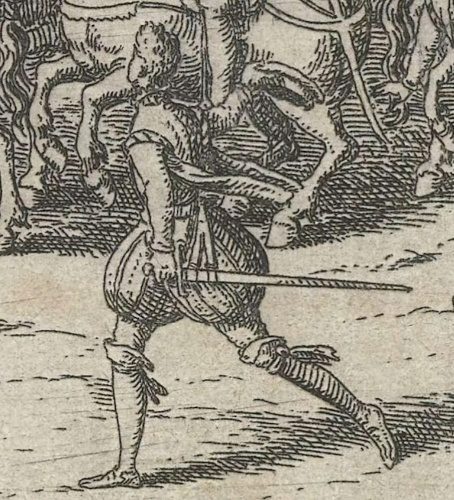
The name for Hanger Swords in England is “cuttoe” while in France, it is “couteaux de chasse.” It is considered to be both a hunter’s and warrior’s sword, as well as a sword of the nobility.
The earliest traces of the Hanger sword are to 16th century Europe. It is a small sword that had a very simple design to it and was mainly used by hunters and infantry. Its light weight made it perfect for daily use by common folk for a number of tasks.
The Hanger Sword was primarily used in Europe and the USA. As the very popular straight rapier became the main sword of Europe, the East influenced and gave birth to the curved sabers. The very crude-looking and easy-to-make Hanger Sword became widely used in many infantry regiments mainly in the 17th and 18th centuries.
While many soldiers had bayonets on their rifles, some preferred to use the Hanger Sword as their backup melee weapon. It was also used by sailors in the navy and was highly popular among the nobility.
The Hanger Sword vs. the Side Sword vs. the Cutlass
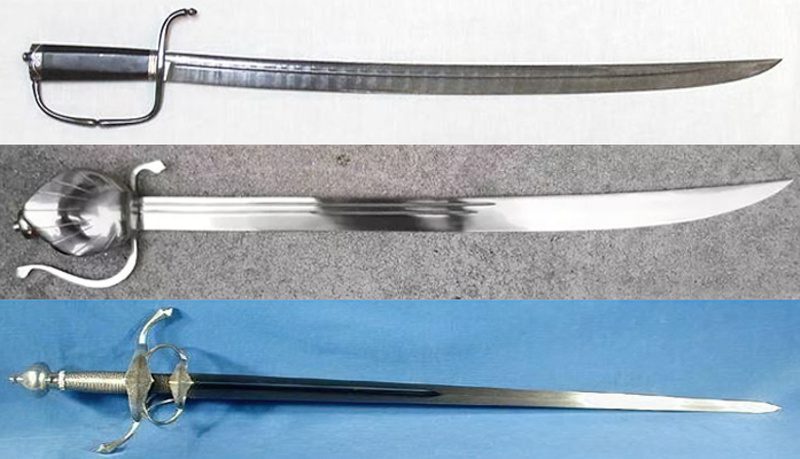
The most distinct characteristics of the Hanger Sword are the slightly curved blade, it’s very short size, and the D-shaped knuckle guard. The main difference between the Hanger sword and the Cutlass is the guard’s shape.
The Cutlass is more or less the same type of sword with the same length and a very similar curved blade. The guard, however, is made semi-circle, which offers more protection but might not be as easy to carry around or “hang” from belts.
The Side sword was also a weapon that was used to hang on belts, hence the name, but the big difference is that it has a straight, thinner, double-edged blade. This weapon was mostly used for duels and thrusting, while the Hanger Sword was primarily for slashes.
Conclusion
The Hanger sword, despite its name, is a very interesting sword that has a lot of uses – more than just hanging on belts. Today a lot of sword enthusiasts use it as a wall mount or get it hand-forged from stainless steel to use for training and sparring.
